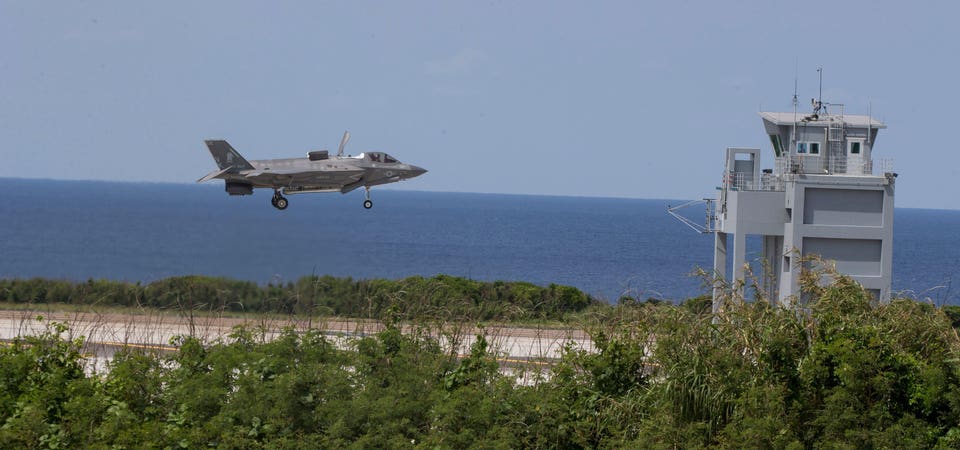
A U.S. Marine Corps F-35B Lightning II fighter aircraft with Marine Fighter Attack Squadron 121 lands at Ie Shima Training Facility during simulated Expeditionary Advanced Base Operations on March 14, 2019.
The Japanese air force plans to base 20 of its new F-35B stealth jump jets at Nittahara air base in Miyazaki Prefecture on Japan’s Kyushu Island.
But don’t count on the single-engine stealth fighters spending much time at Nittahara. Local officials told Miyanichi Press some of the jump jets will embark on the new aircraft carrier Kaga, while others will deploy to an island outpost the Japanese military is building on Mageshima, south of the home islands.
The twin detachments—to Mageshima and Kaga—are central to Tokyo’s war plans. Think of the island outpost as an unsinkable aircraft carrier. The carrier, meanwhile, is a moveable island.
In the event of war with China over Taiwan or some disputed island, F-35s flying from the island and the carrier could form part of a steel barrier between the East China Sea and the Philippine Sea.
U.S. MARINE CORPS PHOTO
U.S. and Japanese warplanes flying from Okinawa and other island bases, farther to the south, would make up the rest of the barrier alongside American and Japanese submarines and Kaga’s sister ship Izumo.
Beijing is building up one of the world’s biggest fleets, one that could allow Chinese forces to attack Taiwan from multiple directions. But to encircle Taiwan, Chinese ships would need to break through one of two maritime chokepoints—one each to Taiwan’s north and south. The F-35Bs would put the squeeze on the northern chokepoint. Imagine one of China’s carrier battle groups—Beijing is currently buildings its third flattop—battling its way past Mageshima as F-35s and submarines hammer at it.
Tokyo last year inked a $23 billion deal with U.S. plane-maker Lockheed Martin to acquire 105 F-35s, including 42 B-models. That’s in addition to 42 conventional F-35s Tokyo previously paid for.
The F-35Bs meanwhile should start arriving in Japan in 2024. Six will go straight to Nittahara, allowing the base’s personnel to get comfortable with the F-35 before the other 14 jets arrive over the next few years.
The Japanese navy plans to modify both of its Izumo-class helicopter carriers so they can operate F-35Bs. The changes include the application of a heat-resistant deck coating plus enlargement of the forward flight deck and removal of a gun on the bow that could impede flight operations. Kaga, the second ship in the class, should be ready first. The 813-foot vessel is scheduled to enter Isogo shipyard in Yokohama City next year for rework. She should leave the yard around the same time the F-35s start arriving at Nittahara.

Stealth Fighters, Flattops And Island Bases—Japan Is Erecting A Wall Of Steel Across The East China Sea
In the event of war with China over Taiwan or some disputed island, F-35B stealth jump jets flying from the carrier Kaga and from a new base being constructed on the southern island of Mageshima could form part of a steel barrier between the East China Sea and the Philippine Sea.
 www.forbes.com
www.forbes.com

